Half of the Global Ocean Race (GOR) fleet is now in the Northern Hemisphere after six and-a-half months in the south with Financial Crisis crossing the Equator in second place at 07:30 GMT on Wednesday. The lead Class40, Cessna Citation, is polling the best averages in north-easterly breeze as the South African duo approach the Equator on Phesheya-Racing with a strong, favourable current beneath their keel, while the Dutch duo on Sec. Hayai have reached the Brazilian port of Fortaleza and are preparing for their crew change.
At 05:50 GMT (02:50 local) on Wednesday, Nico Budel and Erik van Vuuren on Sec. Hayai arrived in Fortaleza and dropped anchor just off the southern breakwater of the city’s busy commercial port. The Dutch duo faced at seven hour wait for the local customs to open their offices before Budel could begin the process of immigration and Yvonne Beusker could join the boat.
Meanwhile, the race leaders, Conrad Colman and Scott Cavanough on Cessna Citation have picked up speed after a windless period trapped in Sargasso weed followed by squalls and have been averaging over nine knots since late GMT on Tuesday night and peaking at 12 knots at 15:00 GMT on Wednesday afternoon in 15-20 knots of easterly wind. “Only two hours into my three-hour first watch for the night and how different from last night with all the squalls,” reported Colman’s Australian co-skipper. “A beautiful, clear night full of stars,” he continues.
However, the stunning canopy was abruptly split in two to the west of Cessna Citation: “About 22:00 UTC, something rather large burned on entry into Earth’s atmosphere,” explains Cavanough, who was 600 miles ESE of the rocket launching and testing facility at Kourou on the coast of French Guiana at the time. “Whatever it was, it left an amazingly long streak as it burned up in the clear sky somewhere over the mouth of the Amazon River.” Closer to the surface of the Earth, the confusion continued: “Just found another kamikazi flying fish,” continues Cavanough. “It had managed to fly down the halyard tunnel!” Amazingly, the fish entered the tunnel’s 100mm X 500mm letter box entry at the mast flying at full pace and exploded into the cockpit by the boat’s halyard and jammer piano between the twin companionway doors. “I cannot describe how hard it must have been for him to have found the hole, but he did it!”

